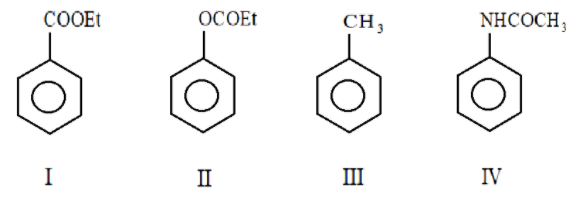Which is/are the correct order of electron density in aromatic ring ?




The correct Answer is:A, B, C, D
To determine the correct order of electron density in an aromatic ring, we need to analyze the effects of various substituents on the benzene ring. The substituents can either be electron-donating groups (EDGs) or electron-withdrawing groups (EWGs), which will affect the electron density in the ring.
1. Identify Electron-Drawing and Electron-Donating Groups:
- Electron-donating groups (EDGs) increase the electron density in the aromatic ring. Examples include -NH2 (amino), -OH (hydroxyl), and -CH3 (methyl).
- Electron-withdrawing groups (EWGs) decrease the electron density in the aromatic ring. Examples include -NO2 (nitro), -CN (cyano), and -Cl (chlorine).
2. Analyze the Effects of Substituents:
- For EDGs:
- The -NH2 group donates its lone pair of electrons to the ring, increasing electron density.
- The -OH group also donates electrons but has a -I (inductive) effect due to the electronegativity of oxygen.
- The -CH3 group has a +I (inductive) effect, which slightly increases electron density.
- For EWGs:
- The -NO2 group is a strong EWG and pulls electron density away from the ring, significantly reducing electron density.
- The -CN group is also an EWG but is less strong than -NO2.
- The -Cl group has both -I and +M effects, but its -I effect is predominant, making it a weak EWG.
3. Rank the Substituents Based on Their Effects:
- The strongest EDG is -NH2, followed by -OH, and then -CH3.
- The strongest EWG is -NO2, followed by -CN, and then -Cl.
4. Establish the Order of Electron Density:
- The order of electron density from highest to lowest can be summarized as:
- Highest: -NH2 > -OH > -CH3 > Benzene > -Cl > -CN > -NO2 Lowest.
5. Conclusion:
- Based on the analysis, we can conclude that the correct order of electron density in the aromatic ring is:
- Option B: -NH2 > -OH > -Cl > Benzene > -CN > -NO2
- Option C: -CH3 > Benzene > -OH > -Cl > -CN > -NO2
- Electron-donating groups (EDGs) increase the electron density in the aromatic ring. Examples include -NH2 (amino), -OH (hydroxyl), and -CH3 (methyl).
- Electron-withdrawing groups (EWGs) decrease the electron density in the aromatic ring. Examples include -NO2 (nitro), -CN (cyano), and -Cl (chlorine).
- For EDGs:
- The -NH2 group donates its lone pair of electrons to the ring, increasing electron density.
- The -OH group also donates electrons but has a -I (inductive) effect due to the electronegativity of oxygen.
- The -CH3 group has a +I (inductive) effect, which slightly increases electron density.
- For EWGs:
- The -NO2 group is a strong EWG and pulls electron density away from the ring, significantly reducing electron density.
- The -CN group is also an EWG but is less strong than -NO2.
- The -Cl group has both -I and +M effects, but its -I effect is predominant, making it a weak EWG.
- The strongest EDG is -NH2, followed by -OH, and then -CH3.
- The strongest EWG is -NO2, followed by -CN, and then -Cl.
- The order of electron density from highest to lowest can be summarized as:
- Highest: -NH2 > -OH > -CH3 > Benzene > -Cl > -CN > -NO2 Lowest.
- Based on the analysis, we can conclude that the correct order of electron density in the aromatic ring is:
- Option B: -NH2 > -OH > -Cl > Benzene > -CN > -NO2
- Option C: -CH3 > Benzene > -OH > -Cl > -CN > -NO2
Topper's Solved these Questions
- GENERAL ORGANIC CHEMISTRY-IBOOK - RESONANCE ENGLISHCHAPTER - GENERAL ORGANIC CHEMISTRY-IEXERCISE - PART-III : PRACTICE TEST-12
1 Video
- GENERAL ORGANIC CHEMISTRY-IBOOK - RESONANCE ENGLISHCHAPTER - GENERAL ORGANIC CHEMISTRY-IEXERCISE - PART-III : PRACTICE TEST-13
1 Video
- GENERAL ORGANIC CHEMISTRY-IBOOK - RESONANCE ENGLISHCHAPTER - GENERAL ORGANIC CHEMISTRY-IEXERCISE - PART-III : PRACTICE TEST-10
1 Video
- GENERAL ORGANIC CHEMISTRY IIBOOK - RESONANCE ENGLISHCHAPTER - GENERAL ORGANIC CHEMISTRY IIEXERCISE - Part-III: Section-5: Matching List Type
1 Video
- HYDROGEN AND ITS COMPOUNDSBOOK - RESONANCE ENGLISHCHAPTER - HYDROGEN AND ITS COMPOUNDSEXERCISE - INORGANIC CHEMISTRY(Hydrogen & its compunds Y environment chemistry)
33 Videos
Similar Questions
The correct order of electron affinity is :-
View SolutionCorrect order of electron affinity is/are:
View SolutionCorrect order of electron affinity is/are:
View SolutionThe correct decreasing order of electron density in aromatic ring of following compounds is :

View Solution
The correct order of electron density in aromatic ring of following compounds is:
View SolutionThe decreasing order of electron density on the ring is :

View SolutionWhat is the correct order of density ?
View SolutionWhich order is correct ?
View SolutionThe correct order of electron gain enthalpy (in kJ/mole) is
View SolutionCorrect order of density is-
View Solution